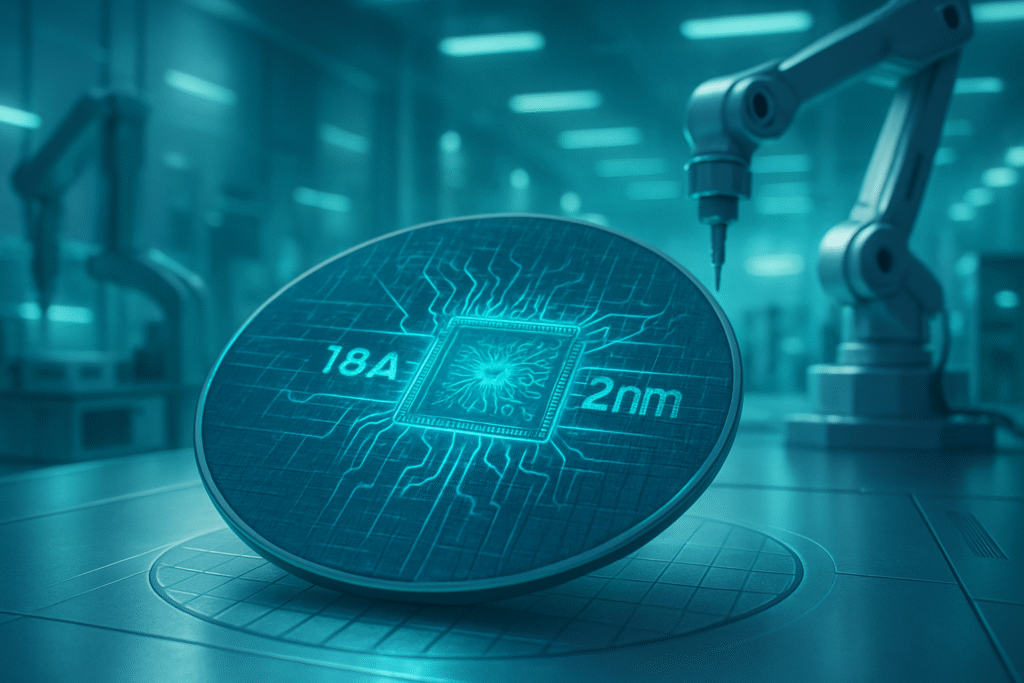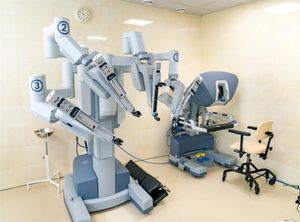
Santa Clara, CA – October 13, 2025 – Intel Corporation (NASDAQ: INTC) is on the cusp of a historic resurgence in semiconductor manufacturing, with its groundbreaking 18A process technology rapidly advancing towards high-volume production. This ambitious endeavor, coupled with a strategic expansion of its foundry business, signals a pivotal moment for the U.S. tech industry, promising to reshape the global chip landscape and bolster national security through domestic production. The company's aggressive IDM 2.0 strategy, spearheaded by significant technological innovation and a renewed focus on external foundry customers, aims to restore Intel's leadership position and establish it as a formidable competitor to industry giants like TSMC (NYSE: TSM) and Samsung (KRX: 005930).
The 18A process is not merely an incremental upgrade; it represents a fundamental leap in transistor technology, designed to deliver superior performance and efficiency. As Intel prepares to unleash its first 18A-powered products – consumer AI PCs and server processors – by late 2025 and early 2026, the implications extend far beyond commercial markets. The expansion of Intel Foundry Services (IFS) to include new external customers, most notably Microsoft (NASDAQ: MSFT), and a critical engagement with the U.S. Department of Defense (DoD) through programs like RAMP-C, underscores a broader strategic imperative: to diversify the global semiconductor supply chain and establish a robust, secure domestic manufacturing ecosystem.
Intel's 18A: A Technical Deep Dive into the Future of Silicon
Intel's 18A process, signifying 1.8 Angstroms and placing it firmly in the "2-nanometer class," is built upon two revolutionary technologies: RibbonFET and PowerVia. RibbonFET, Intel's pioneering implementation of a gate-all-around (GAA) transistor architecture, marks the company's first new transistor architecture in over a decade. Unlike traditional FinFET designs, RibbonFET utilizes ribbon-shaped channels completely surrounded by a gate, providing enhanced control over current flow. This design translates directly into faster transistor switching speeds, improved performance, and greater energy efficiency, all within a smaller footprint, offering a significant advantage for next-generation computing.
Complementing RibbonFET is PowerVia, Intel's innovative backside power delivery network. Historically, power and signal lines have competed for space on the front side of the die, leading to congestion and performance limitations. PowerVia ingeniously reroutes power wires to the backside of the transistor layer, completely separating them from signal wires. This separation dramatically improves area efficiency, reduces voltage leakage, and boosts overall performance by optimizing signal routing. Intel claims PowerVia alone contributes a 10% density gain in cell utilization and a 4% improvement in ISO power performance, showcasing its transformative impact. Together, these innovations position 18A to deliver up to 15% better performance-per-watt and 30% greater transistor density compared to its Intel 3 process node.
The development and qualification of 18A have progressed rapidly, with early production already underway in Oregon and a significant ramp-up towards high-volume manufacturing at the state-of-the-art Fab 52 in Chandler, Arizona. Intel announced in August 2024 that its lead 18A products, the client AI PC processor "Panther Lake" and the server processor "Clearwater Forest," had successfully powered on and booted operating systems less than two quarters after tape-out. This rapid progress indicates that high-volume production of 18A chips is on track to begin in the second half of 2025, with some reports specifying Q4 2025. This timeline positions Intel to compete directly with Samsung and TSMC, which are also targeting 2nm node production in the same timeframe, signaling a fierce but healthy competition at the bleeding edge of semiconductor technology. Furthermore, Intel has reported that its 18A node has achieved a record-low defect density, a crucial metric that bodes well for optimal yield rates and successful volume production.
Reshaping the AI and Tech Landscape: A Foundry for the Future
Intel's aggressive push into advanced foundry services with 18A has profound implications for AI companies, tech giants, and startups alike. The availability of a cutting-edge, domestically produced process node offers a critical alternative to the predominantly East Asian-centric foundry market. Companies seeking to diversify their supply chains, mitigate geopolitical risks, or simply access leading-edge technology stand to benefit significantly. Microsoft's public commitment to utilize Intel's 18A process for its internally designed chips is a monumental validation, signaling trust in Intel's manufacturing capabilities and its technological prowess. This partnership could pave the way for other major tech players to consider Intel Foundry Services (IFS) for their advanced silicon needs, especially those developing custom AI accelerators and specialized processors.
The competitive landscape for major AI labs and tech companies is set for a shake-up. While Intel's internal products like "Panther Lake" and "Clearwater Forest" will be the primary early customers for 18A, the long-term vision of IFS is to become a leading external foundry. The ability to offer a 2nm-class process node with unique advantages like PowerVia could attract design wins from companies currently reliant on TSMC or Samsung. This increased competition could lead to more innovation, better pricing, and greater flexibility for chip designers. However, Intel's CFO David Zinsner admitted in May 2025 that committed volume from external customers for 18A is "not significant right now," and a July 2025 10-Q filing reported only $50 million in revenue from external foundry customers year-to-date. Despite this, new CEO Lip-Bu Tan remains optimistic about attracting more external customers once internal products are ramping in high volume, and Intel is actively courting customers for its successor node, 14A.
For startups and smaller AI firms, access to such advanced process technology through a competitive foundry could accelerate their innovation cycles. While the initial costs of 18A will be substantial, the long-term strategic advantage of having a robust and diverse foundry ecosystem cannot be overstated. This development could potentially disrupt existing product roadmaps for companies that have historically relied on a single foundry provider, forcing a re-evaluation of their supply chain strategies. Intel's market positioning as a full-stack provider – from design to manufacturing – gives it a strategic advantage, especially as AI hardware becomes increasingly specialized and integrated. The company's significant investment, including over $32 billion for new fabs in Arizona, further cements its commitment to this foundry expansion and its ambition to become the world's second-largest foundry by 2030.
Broader Significance: Securing the Future of Microelectronics
Intel's 18A process and the expansion of its foundry business fit squarely into the broader AI landscape as a critical enabler of next-generation AI hardware. As AI models grow exponentially in complexity, demanding ever-increasing computational power and energy efficiency, the underlying semiconductor technology becomes paramount. 18A's advancements in transistor density and performance-per-watt are precisely what is needed to power more sophisticated AI accelerators, edge AI devices, and high-performance computing platforms. This development is not just about faster chips; it's about creating the foundation for more powerful, more efficient, and more pervasive AI applications across every industry.
The impacts extend far beyond commercial gains, touching upon critical geopolitical and national security concerns. The U.S. Department of Defense's engagement with Intel Foundry through the Rapid Assured Microelectronics Prototypes – Commercial (RAMP-C) project is a clear testament to this. The DoD approved Intel Foundry's 18A process for manufacturing prototypes of semiconductors for defense systems in April 2024, aiming to rebuild a domestic commercial foundry network. This initiative ensures a secure, trusted source for advanced microelectronics essential for military applications, reducing reliance on potentially vulnerable overseas supply chains. In January 2025, Intel Foundry onboarded Trusted Semiconductor Solutions and Reliable MicroSystems as new defense industrial base customers for the RAMP-C project, utilizing 18A for both prototypes and high-volume manufacturing for the U.S. DoD.
Potential concerns primarily revolve around the speed and scale of external customer adoption for IFS. While Intel has secured a landmark customer in Microsoft and is actively engaging the DoD, attracting a diverse portfolio of high-volume commercial customers remains crucial for the long-term profitability and success of its foundry ambitions. The historical dominance of TSMC in advanced nodes presents a formidable challenge. However, comparisons to previous AI milestones, such as the shift from general-purpose CPUs to GPUs for AI training, highlight how foundational hardware advancements can unlock entirely new capabilities. Intel's 18A, particularly with its PowerVia and RibbonFET innovations, represents a similar foundational shift in manufacturing, potentially enabling a new generation of AI hardware that is currently unimaginable. The substantial $7.86 billion award to Intel under the U.S. CHIPS and Science Act further underscores the national strategic importance placed on these developments.
The Road Ahead: Anticipating Future Milestones and Applications
The near-term future for Intel's 18A process is focused on achieving stable high-volume manufacturing by Q4 2025 and successfully launching its first internal products. The "Panther Lake" client AI PC processor, expected to ship by the end of 2025 and be widely available in January 2026, will be a critical litmus test for 18A's performance in consumer devices. Similarly, the "Clearwater Forest" server processor, slated for launch in the first half of 2026, will demonstrate 18A's capabilities in demanding data center and AI-driven workloads. The successful rollout of these products will be crucial in building confidence among potential external foundry customers.
Looking further ahead, experts predict a continued diversification of Intel's foundry customer base, especially as the 18A process matures and its successor, 14A, comes into view. Potential applications and use cases on the horizon are vast, ranging from next-generation AI accelerators for cloud and edge computing to highly specialized chips for autonomous vehicles, advanced robotics, and quantum computing interfaces. The unique properties of RibbonFET and PowerVia could offer distinct advantages for these emerging fields, where power efficiency and transistor density are paramount.
However, several challenges need to be addressed. Attracting significant external foundry customers beyond Microsoft will be key to making IFS a financially robust and globally competitive entity. This requires not only cutting-edge technology but also a proven track record of reliable high-volume production, competitive pricing, and strong customer support – areas where established foundries have a significant lead. Furthermore, the immense capital expenditure required for leading-edge fabs means that sustained government support, like the CHIPS Act funding, will remain important. Experts predict that the next few years will be a period of intense competition and innovation in the foundry space, with Intel's success hinging on its ability to execute flawlessly on its manufacturing roadmap and build strong, long-lasting customer relationships. The development of a robust IP ecosystem around 18A will also be critical for attracting diverse designs.
A New Chapter in American Innovation: The Enduring Impact of 18A
Intel's journey with its 18A process and the bold expansion of its foundry business marks a pivotal moment in the history of semiconductor manufacturing and, by extension, the future of artificial intelligence. The key takeaways are clear: Intel is making a determined bid to regain process technology leadership, backed by significant innovations like RibbonFET and PowerVia. This strategy is not just about internal product competitiveness but also about establishing a formidable foundry service that can cater to a diverse range of external customers, including critical defense applications. The successful ramp-up of 18A production in the U.S. will have far-reaching implications for supply chain resilience, national security, and the global balance of power in advanced technology.
This development's significance in AI history cannot be overstated. By providing a cutting-edge, domestically produced manufacturing option, Intel is laying the groundwork for the next generation of AI hardware, enabling more powerful, efficient, and secure AI systems. It represents a crucial step towards a more geographically diversified and robust semiconductor ecosystem, moving away from a single point of failure in critical technology supply chains. While challenges remain in scaling external customer adoption, the technological foundation and strategic intent are firmly in place.
In the coming weeks and months, the tech world will be closely watching Intel's progress on several fronts. The most immediate indicators will be the successful launch and market reception of "Panther Lake" and "Clearwater Forest." Beyond that, the focus will shift to announcements of new external foundry customers, particularly for 18A and its successor nodes, and the continued integration of Intel's technology into defense systems under the RAMP-C program. Intel's journey with 18A is more than just a corporate turnaround; it's a national strategic imperative, promising to usher in a new chapter of American innovation and leadership in the critical field of microelectronics.
This content is intended for informational purposes only and represents analysis of current AI developments.
TokenRing AI delivers enterprise-grade solutions for multi-agent AI workflow orchestration, AI-powered development tools, and seamless remote collaboration platforms.
For more information, visit https://www.tokenring.ai/.






